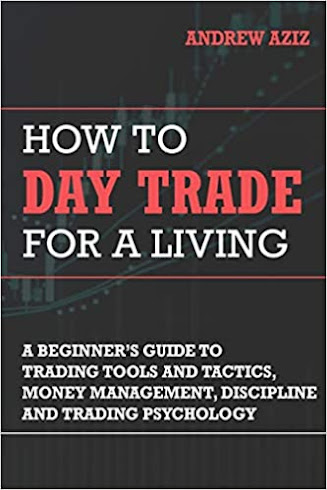A Beginner's Guide to Trading Tools and Tactics, Money Management, Discipline and Trading Psychology | How To Day Trade For A Living
A Beginner's Guide
to Trading Tools and Tactics, Money Management, Discipline and Trading
Psychology : How To Day Trade For A Living
About Author
Andrew Aziz (Ph. D., P. Eng.) is a Canadian stock market
trader, official Forbes Council member, investor and #1 best-selling author. He
has ranked as one of the Amazon top 100 best-selling authors in the
"Business and Finance" category for over 4 consecutive years
(2016-present).
Summary of Book
Have you ever considered quitting your 9 to 5 job for a
career in day trading? Well consider this: - Day trading has a steep learning
curve - Day trading is very competitive Only 16 percent of day traders are
profitable after their first six months. Day trading is a profession and not a
strategy to get rich quick But!... Day
trading can be executed from anywhere in the world where there's a proper
internet connection, including the beaches in Bahamas. Day trading is flexible.
You can be finished by 10:00 a.m. and then do whatever you want doing the rest
of the day. Day trading is a license to print money, if you succeed, and it's
probably the only one that the government won't put you in jail for...
Here I am going to summarizing the most important takeaways
from the book How to Day Trade for a Living
written by Andrew Aziz.
Takeaway # 1 Stocks In
Play:
Day traders always step out of their positions before the
end of the day. That's what separates them from other traders. It's said that
the day trader is only as good as the stocks he's trading, and the best stocks
to day trade are called "stocks in play".
Stocks in play fulfill three
essential criteria: (a) They are
trading at a high relative volume. Meaning that, they are being bought and sold
more than what's typical for the stock. High volume is positive for a day
trader because it's easier to get in and out of trades. (b) They have a fundamental catalyst, such as an earnings report, a
merger, a major product release, a major contract and many more. (c) They are trading independently of
the market, and independently of the market sector that they belong to.
Andrew Aziz uses scanners to find
these stocks. He uses two different types: a pre-market scanner and a real-time
intraday scanner. Once he has established which stocks that are in play, he
will open up their stock charts and set up a plan. He will monitor these stocks
on three separate computer screens, and usually there are only two to three
great stocks per day anyway, so one chart per screen. From here, it's all
guerrilla warfare. The day trader wants to wait for the right opportunity, then
get in quick and get out even faster.
Takeaway #2: The 2 percent rule:
A trader’s primary objective should be to "Live to trade another day".
As mentioned before - only 16% of day traders are profitable after the first
six months. In other words - the learning curve is ruthless! But if you can
survive it, great rewards will come.
As your primary objective is
surviving, the importance of risk management can't be overstated. You must
learn to limit your losses. If you want to reap the long-term profits of a
great trading system, you must be able to survive for the long term first!
Therefore, never risk more than 2% of your total capital in any given trade.
Risking 2% only will allow for
you to be wrong a lot, and still survive because there will be times when you
are wrong. Times when you need to accept defeat, and get out of the trade. And
you might think: "but I don't want to make a thousand dollar loss"!
Well, you definitely don't want to make a five thousand dollar loss! Get out of
the trade! Look for opportunities where you are risking cents to earn dollars.
You want asymmetry in this - a large potential reward but a small downside.
For example, risking a hundred bucks, but
having the potential of gaining a thousand bucks. Your trade is then said to
have a favorable R-multiple.
Takeaway #3:
Understanding the candlesticks:
A day trader’s job is to analyse the balance of the power
between buyers and sellers, and bet on the winning team. Day trading is the
study of mass psychology. Price fluctuations in the market are a result of the
actions of three categories of people - the
Buyers, the Sellers, and the Undecisive. The best way to
illustrate the price fluctuations and the underlying psychology of the market
is with candlestick charts. The candlesticks are a fight between buyers and
sellers. It's an excellent indicator that tells you which group that is
currently winning - the Buying Bulls or the Selling Bears, during that
specific time frame. It can be hourly charts, 5-minute charts or one-minute
charts.
For instance - if the bulls are
currently winning, it can be imagined as the height of the candle expresses how
much the buyers are currently winning by so, in the following candle here, we
see that they win by a smaller margin than before, and the price increases by a
smaller amount as a result. Positive price action is represented by a hollow
candlestick. On the other hand, if the bears are currently winning the battle,
it will be represented by a filled, often red candlestick.
Sometimes, the battle is
indecisive. This is then represented by an indecision candlestick, a very thin
one, meaning that the price fluctuation during that time was minor. For a chart
to be complete, it should also be accompanied by the trading volume for each
time frame. The trading volume acts as a great complement to the price
movements. A high trading volume accompanied by either a sharp movement in the
stock price or an indecisive one is an interesting situation, which the day
trader can profit from as we shall see in the following two takeaways.
Takeaway #4: The
Support and Resistance Strategy:
Many traders love to identify complicated chart patterns if
they are accompanied by ridiculous names - all the better apparently. Try
Google search "the abandoned baby", "the dark cloud cover"
or "the three black crows". Andrew Aziz never believed in these. If
you make it too complicated, your risk curve-fitting and if the patterns are
too arbitrary, they become subjective and suddenly you can see them everywhere.
Instead, Andrew Aziz prefers to
use primarily two very simple trading strategies: Support or resistance trading and VWAP-trading. Support is trading terminology and means that a
stock is showing respect for a certain price point. If the stock has bounced
back up from such a point before, you can expect it to do so in the future as
well. Resistance is the opposite - it acts as a ceiling from which the stocks
uptrend is reversed. Here's how you trade using the support strategy. 1. Each morning before the stock
exchange opens, find areas of support and resistance for your stocks in play. 2. Look for indecision candles around
the support area accompanied by high trading volume. Set up your stop-loss
slightly below the support area, on a five minute chart. 3. Keep the trade until the next support or assistance area. 4. If there's an obvious second support
or resistance area, you may sell half your position at the first level, move
your stop-loss up to break-even, and save the other half for that second level.
Mirror this and you get how to short using the resistance strategy.
Takeaway #5: The VWAP
Strategy:
VWAP means volume weighted average price, and this
is the most important technical indicator in learning how to day trade for a
living, according to Andrew Aziz. For now, it will be sufficient to say that
it's a moving average, and that it takes into account the volume of shares that
have been traded. If the stock price currently is above the VWAP, it's a bullish indication. And if
the situation is reversed, it's a bearish indication.
VWAP should be included in your
trading platform, otherwise you should switch platform. So, How do you set up a
trade with it? 1. See if the stock
in play shows respect for VWAP as a support. 2. Buy slightly above the VWAP and set up a trailing stop, slightly
below. A break on a five-minute chart should get you out of the trade. 3. Keep your position until the next
level of resistance. In this case, the next resistance level was expected to be
the "whole-dollar" level of $22 dollars. 4. You may sell half the position close to the resistance level,
and move up your stop-loss to your buying point. If you mirror everything you
can use the VWAP short selling too.
The key for now should be to
master just one strategy. So pick either VWAP or support and resistance, and
start trading it in a trading simulator. Not over-complicating your strategies
will allow for you to focus on what's really important - the psychological
aspects of the game.
Day trade only stocks in play. Never risk more than 2% in any given
trade. Candlestick charts! The support and resistance strategy is simple and
efficient. The VWAP strategy is simple
and efficient too. Trading is much like learning to ride a bicycle - once
you've mastered this skill, no one can take it away from you.






Comments
Post a Comment